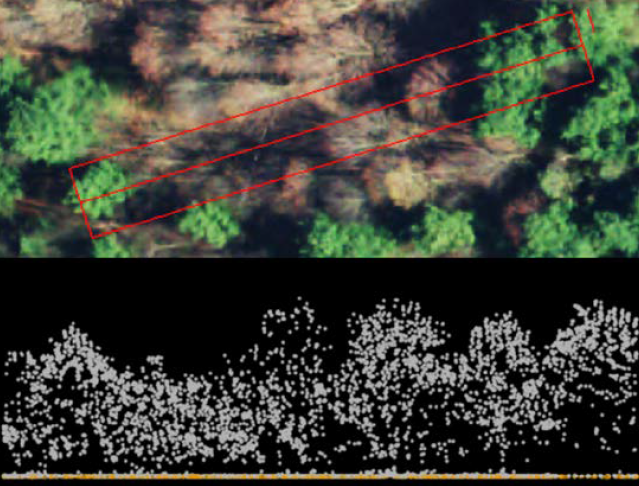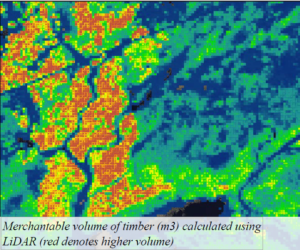
How the Ontario Woodlot Association is Using LiDAR to Help Woodlot Owners Make Decisions by Ben Gwilliam, MFC Student
Article written for The Ontario Woodlander, Issue 103 (June 2021), a publication of the Ontario Woodlot Association where Ben Gwilliam is currently working his MFC program summer internship.
Woodlots provide us with fuel, timber, wildlife habitat, and ecosystem services that will help us to mitigate climate change, but how can landowners measure these to get a sense of their value? Traditional methods of forest mensuration involve cruising a stand on foot and analyzing aerial imagery to glean data on tree height, timber volume, and species. But over the past two decades in forestry, significant advances have been made in developing aerial laser technology, or LiDAR, that can measure vast forest areas from the air with precise three-dimensional detail. LiDAR has been proven to provide an unparalleled degree of information to help manage our natural resources, prompting the Ontario government to invest $84.5 million in its use over the next ten years1. That same degree of information is now being leveraged by the OWA to support an economic analysis of private forests that will give members the decision support tools to realize the financial benefits of good forestry practices on their property.
For now, this LiDAR economic valuation pilot is being conducted in only one county. But the lessons learned may contribute to a project encompassing all of Southern Ontario with the ability to incorporate the forest inventory attributes of private lands and non-timber values, such as habitat quality and carbon sequestration.
What is LiDAR?
 LiDAR stands for Light Detection and Ranging and uses laser light to capture information on the distance and shape of objects. A sensor attached to the bottom of an airplane emits billions of laser pulses that bounce off objects and return to the sensor with information on the x, y, z coordinates of where that bounce took place. The airplane has an ultra-sensitive GPS and accelerometer, making it so the precise locations of these bounce points can be located in space. And by using the speed of light, the exact distances of these points from the ground and to the airplane can be calculated. This means that from billions of these points in space, 3D images–or point clouds–
LiDAR stands for Light Detection and Ranging and uses laser light to capture information on the distance and shape of objects. A sensor attached to the bottom of an airplane emits billions of laser pulses that bounce off objects and return to the sensor with information on the x, y, z coordinates of where that bounce took place. The airplane has an ultra-sensitive GPS and accelerometer, making it so the precise locations of these bounce points can be located in space. And by using the speed of light, the exact distances of these points from the ground and to the airplane can be calculated. This means that from billions of these points in space, 3D images–or point clouds–
are formed, which can be used to survey topography, archeological sites, and forest vegetation with a level of accuracy measured in centimetres. In forestry, the benefit comes from the laser’s ability to penetrate the canopy down to the forest floor, providing continuous vertical measurements of trees from the bole to the canopy’s apex. And unlike a timber cruise which often uses a sample
to measure large areas, LiDAR is a complete census of every stem and crown in the forest and can be done over thousands of kilometres in hours.
1979 was the last year the forests of Southern Ontario were inventoried. Since then, the patchwork of harvest reports, maps, and MFTIP plans are all that exist to gain insight into the current state of Southern Ontario’s forest resources. The OWA has advocated for access to better information for its members to help make decisions for managing their property. This economic analysis with LiDAR data will provide an unprecedented examination of the availability and value of wood products on private lands in the province. It will also be the first step to inventorying the rest of Southern Ontario.
The pilot project is being run within the United Counties of Prescott and Russell (UCPR), a municipality a half-hour east of Ottawa. UCPR flew LiDAR over their 2000 km2 county area as part of a watershed study in 2014. This project uses that LiDAR data to model forest inventory attributes across all forested regions of the county, providing such attributes as: merchantable volume, stand height, stems per ha, and total above-ground biomass. The next step will investigate species classifications using multispectral satellite imagery and apply growth and yield models. And from this, analyze different silviculture treatment scenarios that will provide the greatest return on ree growth. This approach will also be connected to six individual case studies of FSC certified woodlots in the Prescott and Russell region that will allow a more detailed analysis of the economic value of good management.
 So far, the project has been an extensive undertaking across institutions and disciplines. It has included former MNRF remote-sensing specialist Murray Woods, myself – a Masters of Forest Conservation student from the University of Toronto, Dr. Kym Snarr, York University Professor of Geomatics Engineering Dr. Baoxin Hu, Professor Ben Kuttner (UofT), with many others offering their wisdom and resources. Other partners include the Center for Research & Innovation in the Bioeconomy (CRIBE),
So far, the project has been an extensive undertaking across institutions and disciplines. It has included former MNRF remote-sensing specialist Murray Woods, myself – a Masters of Forest Conservation student from the University of Toronto, Dr. Kym Snarr, York University Professor of Geomatics Engineering Dr. Baoxin Hu, Professor Ben Kuttner (UofT), with many others offering their wisdom and resources. Other partners include the Center for Research & Innovation in the Bioeconomy (CRIBE),
the Forestry Futures Trust (FFT), Cascades Inc., and the Eastern Ontario Model Forest (EOMF).
What are the benefits?
There is an adage which states that “you can’t manage what you can’t measure,” and good forest management starts with good measurement tools that can aid in decision-making. For the woodlot owner, LiDAR provides insight into the location, size, quantity, and with the economic model, the value of their timber before hiring a professional to develop a management plan. Additionally, property owners can use the information from a LiDAR analysis to identify habitat structures for mammals or nesting birds, plan recreation trails or roads, or estimate the amount of carbon your property sequesters. The OWA’s goal is to make this information accessible to all members across the province so that they can investigate how actively managing their forests through harvesting or thinning will benefit multiple values and promote good stewardship of natural resources.
2D cross section of LiDAR data below from the sample immediately above.
Could LiDAR ever replace “dirt forestry”? Absolutely not. Much still cannot be seen with LiDAR, such as forest and tree condition, for example, what trees may be deemed acceptable and unacceptable growing stock in deciding what trees to harvest and what trees to retain to add high-value growth. The trained eye and counsel of a forester will always provide a more holistic solution to forest management. LiDAR simply adds one more tool to the toolbox, and the OWA will continue to collaborate in making this technology more accessible and provide OWA members with the best decision support tools that will maximize the values of their forests.
The economic analysis of UCPR is anticipated to be released by the OWA in the fall of 2021.
References
[1] https://www.woodbusiness.ca/ontario-releases-finalforest-
sector-strategy-including-84-5m-to-enhance-forestinventory/
Click here to read the full issue of The Ontario Woodlander, Issue 103





